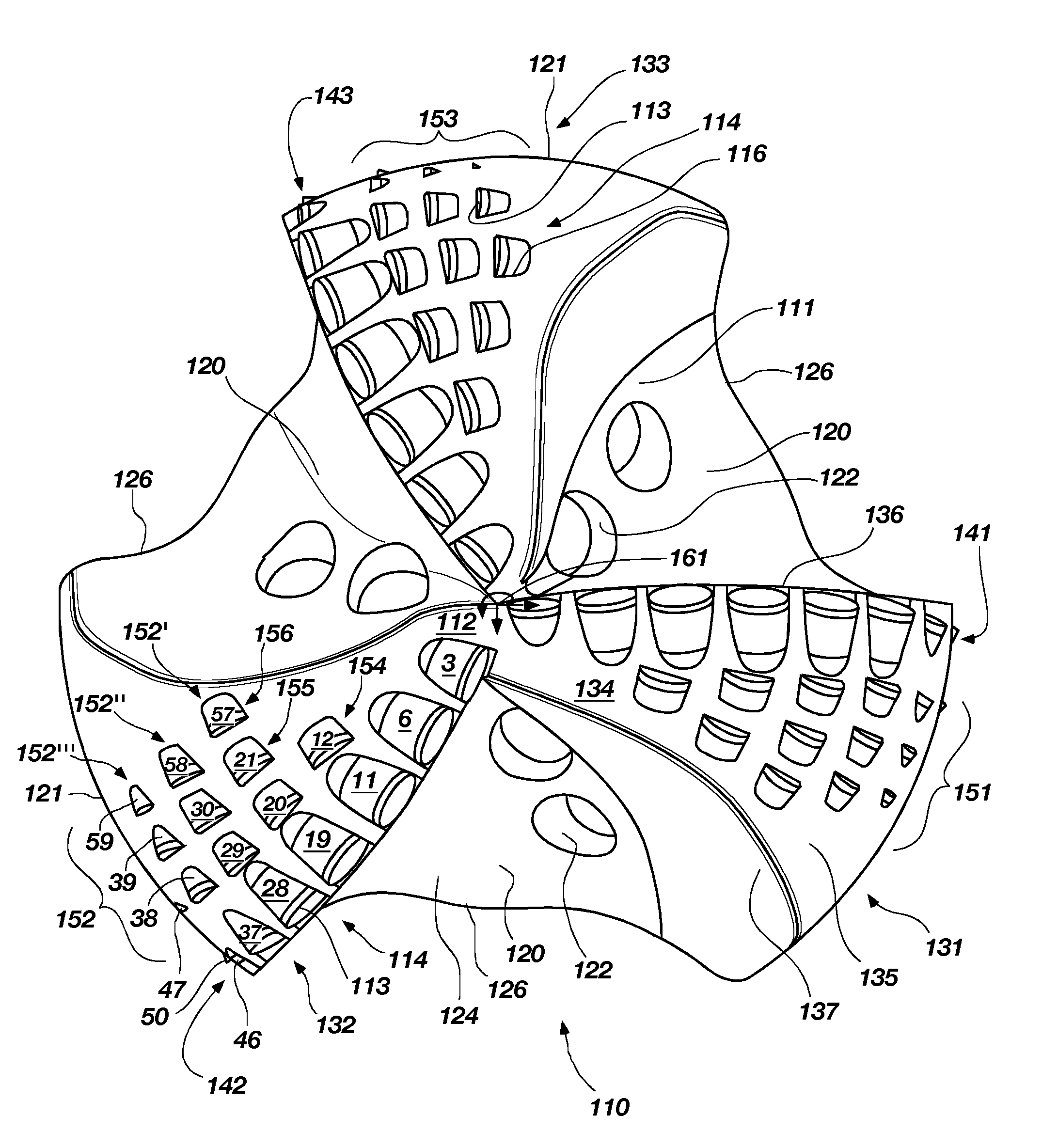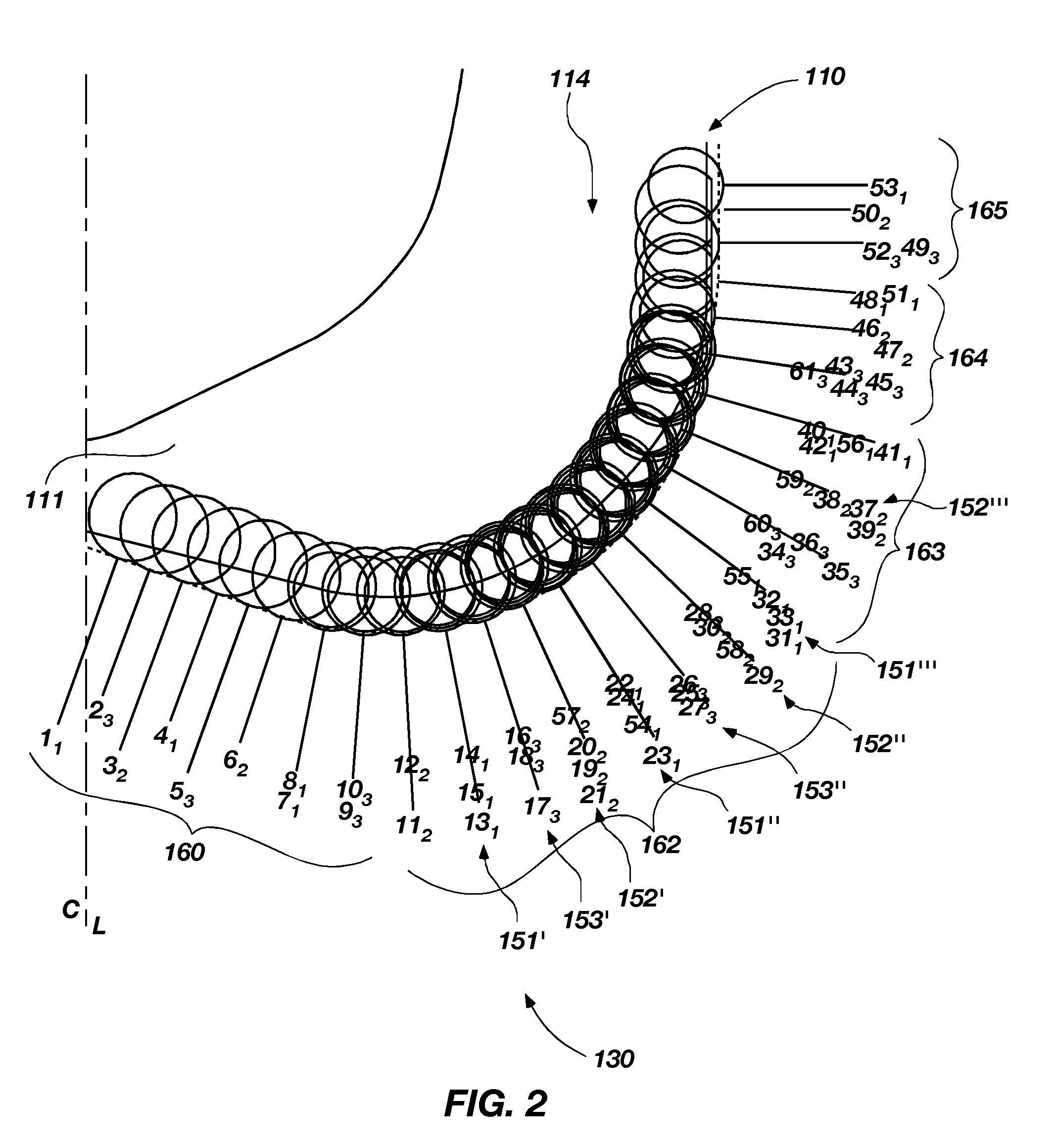Rotary drag bit
a rotary drag bit and cutting element technology, applied in earth drilling, drilling accessories, construction, etc., can solve the problems of shortened life of rotary drag bits using such cutting elements, shortened cutting life wear of cutting elements of rotary drag bits, so as to prolong cutter life, reduce stress on cutters, and improve cutting efficiency.
- Summary
- Abstract
- Description
- Claims
- Application Information
AI Technical Summary
Benefits of technology
Problems solved by technology
Method used
Image
Examples
first embodiment
[0060]FIG. 1 shows a frontal view of a rotary drag bit 110 in accordance with the invention. The rotary drag bit 110 comprises three blades 131, 132, 133, three primary cutter rows 141, 142, 143 and three multiple backup cutter groups 151, 152, 153, respectively. While three multiple backup cutter groups 151, 152, 153 are included, it is contemplated that the drag bit 110 may include one multiple backup cutter group on one of the blades or a plurality of backup cutter groups on the blades greater or less than the three illustrated. Further, it is contemplated that the drag bit 110 may have more or less blades than the three illustrated. Each of the multiple backup cutter groups 151, 152, 153 may have one or more multiple backup cutter sets. For example, without limitation, the multiple backup cutter group 152 includes three multiple backup cutter sets 152′, 152″, 152′″. Before turning to a detailed description of multiple backup cutter sets 152′, 152″, 152′″ of the multiple backup c...
second embodiment
[0083]FIG. 5 shows a frontal view of a rotary drag bit 210 in accordance with the invention. The rotary drag bit 210 comprises six blades 231, 231′, 232, 232′, 233, 233′ each having a primary or first cutter row 241 and a backup or second cutter row 251 extending from the center line C / L of the bit 210. The cutter rows 241, 251 include cutters 214 coupled to cutter pockets 216 of the blades 231,231′, 232, 232′, 233, 233′. It is contemplated that each blade 231, 231′, 232, 232′, 233, 233′ may have more or less cutter rows 241, 251 than the two illustrated. Also, each of the cutter rows 241, 251 may have fewer or greater numbers of cutters 214 than illustrated on each of the blades 231, 231′, 232, 232′, 233, 233′. In this embodiment, blades 231, 232, 233 are primary blades and blades 231′, 232′, 233′ are secondary blades. The secondary blades 231′, 232′, 233′ provide support for adding additional cutters 214, particularly, in the nose region 262 (see FIG. 6) where the work requirement...
third embodiment
[0091]FIG. 13 shows a frontal view of a rotary drag bit 310 in accordance with the invention. The rotary drag bit 310 comprises three primary blades 331, 332, 333 each comprising a primary or first cutter row 341, 342, 343, a backup or second cutter row 344, 345, 346, and an additional backup or third cutter row 347, 348, 349, respectively, extending radially outward from the center line C / L of the bit 310. Optionally, one or more additional backup cutter rows may be provided upon at least one of the blades 331, 332, 333 beyond the first cutter rows 341, 342, 343 and the second cutter rows 344,345, 346 illustrated. The cutter rows 341, 342, 343, 344, 345, 346, 347, 348, 349 include a plurality of cutters 314; each cutter 314 coupled to a cutter pocket 316 of the blades 331, 332, 333.
[0092]The cutters 314 in cutter rows 341, 342, 343 are fully exposed cutters as shown in FIG. 14, which shows a cutter and blade profile 330 for the third embodiment of the invention. The drag bit 310 ha...
PUM
 Login to View More
Login to View More Abstract
Description
Claims
Application Information
 Login to View More
Login to View More - R&D
- Intellectual Property
- Life Sciences
- Materials
- Tech Scout
- Unparalleled Data Quality
- Higher Quality Content
- 60% Fewer Hallucinations
Browse by: Latest US Patents, China's latest patents, Technical Efficacy Thesaurus, Application Domain, Technology Topic, Popular Technical Reports.
© 2025 PatSnap. All rights reserved.Legal|Privacy policy|Modern Slavery Act Transparency Statement|Sitemap|About US| Contact US: help@patsnap.com



